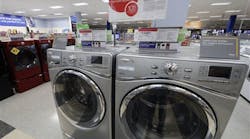WASHINGTON -- New orders for US manufactured durable goods such as cars, airplanes and computers rose in March, the second straight gain of the year.
Durable goods orders rose by 2.6% to $234.8 billion, after a 2.2% rise in February, the Commerce Department said.
The March increase came in well above the consensus estimate of 2%, thanks to commercial aircraft, communications equipment, primary metals and computers.
Transportation equipment, also up two consecutive months, led the increase, leaping 4% to $74.1 billion. Commercial airplane orders jumped 8.6%.
Excluding transportation, which tends to be volatile month-over-month, so-called "core" durable goods orders increased 2%, solidly beating analysts' expectations of a 0.5% rise.
“Of importance to both the manufacturing sector and the economy as a whole, business equipment spending appears to have rebounded from a difficult winter,” noted Cliff Waldman, senior economist for the Manufacturers Alliance for Productivity and Innovation (MAPI). “New orders for non-defense capital spending excluding aircraft, a proxy for business equipment demand, rose 2.2% in March, more than reversing a 1.1% decline in February. Year-over-year (year-to-date), however, this critical index is up only 1.9% and we have yet to see business investment break out of its unusually weak and volatile performance.
"Signs of more accommodative commercial and industrial credit as well as strengthening demand for commercial loans might suggest that capital spending will pick up and stabilize later this year. For now, though, it remains a laggard in the economic picture.
“All told, recent evidence suggests that manufacturing has shaken off its winter blues but is still confronting a challenging business climate,” Waldman concluded. “The U.S. economy's growth performance remains steady—though frustratingly slow—and the global environment is facing numerous regional issues, including an extended slowdown in China and deflation risk in the Eurozone. Moderate growth with a modest downside risk is the most likely path for the U.S. factory sector through the balance of 2014.”
Copyright Agence France-Presse, 2014



